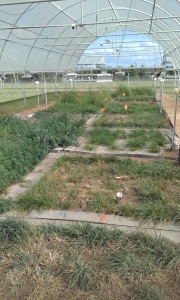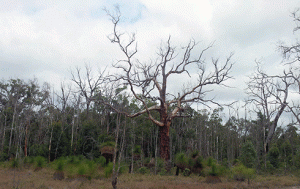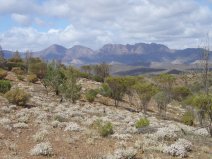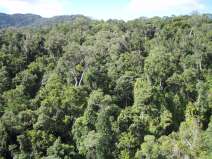The Big Deal: The DAVE (Dynamics of Australian VEgetation) Project
Climate clearly plays an incredibly strong role in determining what vegetation grows where in Australia. With climate already changing, our vegetation is very likely to change too. Funded by an Australian Research Council Laureate Fellowship, the DAVE project team aims to develop a Dynamic Vegetation Model that can predict what vegetation grows where in Australia, and how that may change in the future. It’s a big, challenging project. Current dynamic vegetation models do not capture well the key processes that determine vegetation distributions in Australia, which include temperature, aridity, soil nutrient availability (especially phosphorus) and fire. They also not represent well the types of vegetation that we have here, such as the mighty Eucalypt and the super-resilient arid zone vegetation. Our team is working closely with many experimental scientists, at the Hawkesbury Institute and elsewhere, to develop a model that can better describe our vegetation. The model will be an important scientific tool to aid ecological understanding, but will also be valuable to inform better policy and land management through its predictions of ecosystem function such as carbon sequestration, water use, and flammability.
Some of Our Other Research Projects
The Influence of Climate Change on Bushfire Fuels in Victoria (2021 – 2023) Victorian Country Fire Authority; CI’s Mingkai Jiang, Matthias Boer, Rachael Nolan, Belinda Medlyn, Ben Smith, Owen Price (University of Wollongong) Climate change is rapidly changing patterns of bushfire behaviour through its direct effect on fire weather but also its effect on fuel loads. This project applies machine learning and dynamic vegetation modelling approaches to predict potential changes in fuel loads across Victoria in future.
Determining the physiological underpinnings of eucalypt dieback in NSW (2021-2024) NSW Environmental Trust; CI’s Brendan Choat, Belinda Medlyn, Ben Smith, Matthias Boer, Rachael Nolan, David Tissue, Mark Tjoelker, Sebastian Pfautsch, Paul Rymer, Adam Roff Tree mortality (dieback) is a major environmental issue facing NSW. Although multiple causal factors are associated with dieback (e.g. pests, pathogens, disturbance), drought stress is the most widespread factor with the potential to kill millions of trees over short time scales. Extreme drought events and heatwaves will increase in the future, so it is essential to evaluate risks to Eucalyptus species associated with rapid environmental change. In this project we are measuring critical physiological thresholds associated with drought and heat stress in order to evaluate the vulnerability and resilience of Eucalyptus species across a range of forest and woodland environments in NSW.
 Brown is the new green: Grassland responses to drought and heat (2018 – 2020) ARC Discovery project; CI’s Belinda Medlyn, Elise Pendall, Sally Power, David Tissue; PI’s Alan Knapp, Melinda Smith (Colorado State University) Grassland ecosystems are important reservoirs of global biodiversity and carbon storage. Grasslands are highly sensitive to drought and heat stress, but we recently showed that current grassland models cannot predict these responses because they do not adequately represent the key processes of physiological drought tolerance, leaf browning, and species traits. We will capitalise on new experimental infrastructure (such as PACE, DriGRASS, DroughtNet) to collect targeted data sets in order to develop and test model representations of these key processes. Our goal is to greatly increase capacity to predict the impact of drought and heat stress on grasslands, at scales ranging from field to globe.
Brown is the new green: Grassland responses to drought and heat (2018 – 2020) ARC Discovery project; CI’s Belinda Medlyn, Elise Pendall, Sally Power, David Tissue; PI’s Alan Knapp, Melinda Smith (Colorado State University) Grassland ecosystems are important reservoirs of global biodiversity and carbon storage. Grasslands are highly sensitive to drought and heat stress, but we recently showed that current grassland models cannot predict these responses because they do not adequately represent the key processes of physiological drought tolerance, leaf browning, and species traits. We will capitalise on new experimental infrastructure (such as PACE, DriGRASS, DroughtNet) to collect targeted data sets in order to develop and test model representations of these key processes. Our goal is to greatly increase capacity to predict the impact of drought and heat stress on grasslands, at scales ranging from field to globe.
To grow or to store: Do plants hedge their bets? (2016 – 2018) ARC Discovery project; CI’s Belinda Medlyn, Remko Duursma, Roderick Dewar (Australian National U), Mat Williams (U Edinburgh) This project aims to resolve a long-standing question about the function of perennial plants: how much of the carbon taken up by photosynthesis is used immediately for growth, and how much is kept in reserve as insurance against future stress? This question is fundamental to our understanding of how plants respond to stresses such as insect infestation and severe drought, and yet lack of data and theoretical modelling currently hampers our ability to answer it. By applying novel data analysis and modelling tools to recent experimental results, we will test alternative hypotheses for how plants allocate carbon between growth and storage in response to stress.
Identifying regions of high drought mortality risk for tree species in New South Wales (2015 – 2017) ARC Linkages project with Office of Environment and Heritage and Macquarie University; CI’s Belinda Medlyn, Linda Beaumont, Brad Evans, David Tissue, Remko Duursma, Paul Rymer, Mark Tjoelker, Tony Auld, Brendan Choat, Martin De Kauwe

Drought mortality in WA (Photo courtesy Brad Evans)
Climate change is likely to increase the occurrence of climatic extremes of drought and heat, provoking large-scale tree mortality episodes. Mortality episodes have been observed in a wide range of forest types globally and in Australia (including river redgum, Cunningham et al. 2007; savanna, Fensham et al. 2009; jarrah, Matusick et al. 2013). However, not all vegetation types are equally at risk, because the likely severity of future droughts is variable across the landscape, and because sensitivity to drought varies among species. In this project, we aim to identify regions of NSW where future tree mortality risk is high. We are using physiological and ecological approaches to identify the drought tolerance of key habitat-structuring species and using future climate scenarios to work out where these tolerances might be exceeded. Ultimately we aim to develop maps of mortality risk that can help inform land management in NSW.
Turning water into carbon: a synthesis of plant water-use efficiency from leaf to globe (2012 – 2014) ARC Discovery project; CIs Belinda Medlyn, Remko Duursma, Colin Prentice, Almut Arneth. Post-doc Dr Yan-Shih Lin
Plant water use efficiency is the amount of carbon gained per unit water transpired, is a fundamental determinant of ecosystem function. Controlled by stomatal behaviour, it governs plant productivity, hydrology, and vegetation distribution. It has been very frequently measured, but there was little understanding of how it varies, due to a lack of theory to tie the observations together. We developed a new theory for water use efficiency and put together global data sets across a wide range of scales to develop a new, broad understanding of how water use efficiency varies.
Elevated CO2 effects on vegetation: repairing the disconnect between experiments and models (2010 – 2013) ARC Discovery Project; CIs Belinda Medlyn, Michelle Leishman, Sune Linder, Rich Norby, Ram Oren. Post-doc Dr Martin De Kauwe.
Atmospheric CO2 is currently increasing at an unprecedented rate, which has important consequences for vegetation: plants can photosynthesise faster and shut their stomata to conserve water. Ecosystem models need to take these effects into account, but to do so they need to be solidly based on experimental evidence. Our goal in this project was to synthesise data from a wide range of high-CO2 experiments in ways that could be used to inform models. We contributed to a model comparison of the Duke and ORNL forest FACE experiments that led to a solid understanding of which CO2 effects models capture and which they don’t. We’re now applying similar methods to the new EucFACE experiment at UWS. We also tested and developed models for the effects of atmospheric CO2 on stomatal behaviour, the interactions with drought and temperature, the response of different species types, and the implications for competition among species.




